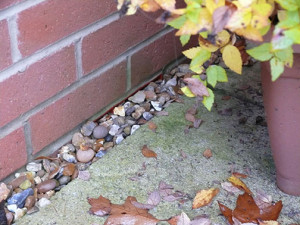Moisture and damp is the enemy of any property. Able to gradually penetrate the fabric of the building it is responsible for rot, degradation, new and aggravated health issues for the occupants and a whole host of costly remedial work.
Prevention is better than cure and providing a house with adequate and effective ventilation is the key to preventing moisture laden air from taking hold. It is also crucial in certain areas of the UK for reducing naturally occurring, dangerous gases such as radon and methane.
Robust detailing for sub-floor ventilation gives a property the best start in the fight against moisture, damp, dangerous gases and even flooding. The Building Regulations Approved Document C states suspended timber floors and suspended concrete floors (including block and beam) have a provision for ventilation on two opposing external walls of not less than 1500mm² per metre run of external wall or 500mm² per metre² of floor area, whichever works out to give the greater amount of ventilation.
Once the ventilation rate has been established, we recommend a detailed specification with product code, air brick colour and manufacturer’s information which will help ensure that the supply and build is as intended. As all manufacturers’ underfloor ventilators have different airflows, an open specification could result in the use of products which provide a lower rate of ventilation than originally intended leaving the sub-floor under ventilated.
It’s also important to ensure that ventilation has a free and unobstructed path to all areas. If the void has internal sleeper walls, provision should be made for ventilation to pass through those barriers and give protection, so as no part of the floor void is left to stagnate and become susceptible to moisture.
External landscaping should also be considered in the positioning of air bricks for sub-floor ventilation. If overlooked it can result in air bricks being permanently obstructed by hard landscaping such as patios and pathways or blocked by close proximity to bushes and seasonal debris.
If the property is in a flood risk area consideration may be given at design stage to raising the position of the sub-floor air bricks higher than the traditional dpc level. Raising the height of the air bricks above ground level will shift the first entry point for flood water to other much smaller openings which could significantly reduce the volume of flood water entering the property.
Raising the height of the air bricks is a simple yet effective flood prevention measure. It is cost efficient and offers built-in protection to the occupants. However, it does rely on the capability of the underfloor ventilation system to be extended vertically by some distance. Vertical extenders are available from most manufacturers of sub-floor ventilators although they do vary in length and shorter ones may work out more costly and be more time consuming to install than longer lengths.
Rytons Periscope® Underfloor Ventilator (PUFV) is a cranked z-shape underfloor ventilator capable of extending vertically through 2-5 brick courses as a single unit. The external Multifix® Air Brick boasts one of the highest airflows on the market at 7,750mm² per unit which, unrestricted by the Periscope® sleeve, provides highly effective sub-floor ventilation.
When differentials between the ground level and sub-floor void are greater than 5 brick courses, a 1m long Rytons Periscope Vertical Extension (PUFVVEXT) is available to raise the vertical height of the periscopic unit. Easily cut to the required length and simply inserted between the top and bottom sections of the Periscope® Underfloor Ventilator, it allows a good flexibility for positioning and is ideal to raise the air brick above ground level as a preventative measure against flooding.
For convenience Rytons has an online underfloor ventilation calculator to assist with sub-floor ventilation calculations. Alternatively, contact the technical team for help.
NBS Plus specifications are available from the technical product pages of Rytons Periscope® Underfloor Ventilator (PUFV), Multifix® Air Brick (MFAB) and Periscope® Vertical Extension (PUFVVEXT).

All information given is in good faith and to the best of our knowledge is true and accurate at the date of publication. However, no guarantee regarding its accuracy is given, nor should Rytons representatives or agents imply any such guarantee. Customers should satisfy themselves that the products are suitable for the intended purpose.
